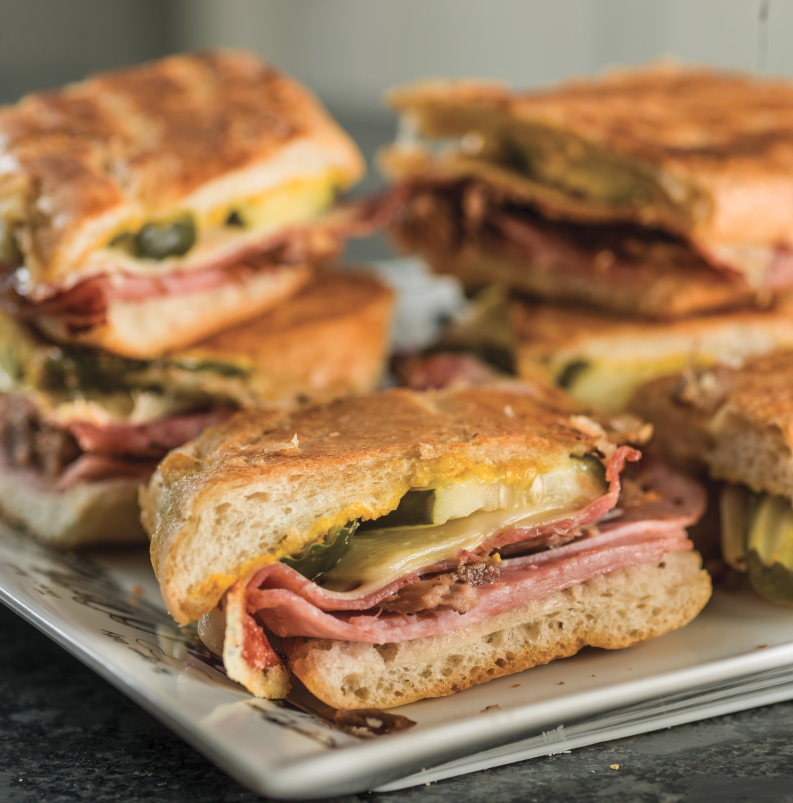
THE ORIGIN: Most historians believe the Cuban sandwich, also known as the Cubano, was created in Ybor City in the late 1800s by Cubans who immigrated to Tampa.
Ham, roast pork, cheese, pickles, Cuban bread and sometimes Italian Genoa salami, depending upon whether you live in Tampa or Miami (Cubans in Tampa have it). Butter, mustard, lettuce and tomato are optional.
Cubans are traditionally served pressed, but some prefer cold or room temperature.
Cuban sandwiches are grilled in a sandwich press, called a plancha, until the meat and pickles have warmed in their own steam. The heat and weight of the press fuse the meat, cheese and bread. If the press is too light, the sandwich won’t come out as well. A heavy press hand pushes the juices and flavors together for the desired taste.

Hot or cold. Pressed or non-pressed. With salami or without it. No matter how you like your Cubano, no single ingredient used to make these delectable treats is more important to its quality than the bread. This isn’t opinion, but fact, say those in the business. And for the best sandwich, only one type of bread is acceptable: Cuban.
According to What’s Cooking America, La Joven Francesca Bakery in Ybor City was the first place to bake Cuban bread. Established by Francisco Ferlita, a Sicilian, in 1896, the bakery was a major source of Ybor City’s daily bread, selling for 3 and 5 cents a loaf. A major fire destroyed the bakery in 1922, and the brick oven was all that was left standing. Ferlita rebuilt the bakery, and, during its peak years, it could produce 1,500 loaves per day. The bakery closed in 1973 and reopened as the Ybor City State Museum in 1974.
La Segunda Central Bakery opened in Ybor City in 1915; today, the bakery remains a top supplier of the area’s Cuban bread. The third-generation, family-owned bakery produces about 9,000 loaves a day.
“We grew up with most of the big businesses [in Tampa],” said Raymond Moré, who co-owns La Segunda with his cousin, Anthony Moré.

La Segunda was established by Juan Moré (pronounced Moor-ay), grandfather to Raymond and Anthony and a native of Spain. La Segunda’s loaves have a crisp, flaky crust and a bloom down the center that is created in a unique manner. It comes from placing a long palmetto frond atop the loaf before it is baked.
La Segunda is in its third location. The first building, which sat in the heart of Ybor City on Eighth Avenue, was made from wood and destroyed by a fire. The second location was catty-corner to its current spot on 15th Street. A move from that building had to be made about 40 years ago because the interstate was built.
La Segunda has ties to many area eateries, including Ybor’s famed Columbia Restaurant. The Columbia opened in 1905, and when La Segunda came to be 10 years later, it began providing the restaurant with bread — something it still does today.
“We’ve serviced them the whole time,” Raymond said.
La Segunda employs about 32 people, and 24 of them are responsible for making the bread. The bakery produces small loaves (18”) and large ones (36”). It takes about seven hours to create a loaf, which is made from flour, salt, sugar, water and yeast. Lard used to be a mainstay in the process, but these days more bakeries such as La Segunda are using animal and vegetable shortening.
The bakers shape the bread into one-pound blocks by hand, the palmetto is applied and then they are placed into the oven one by one. Each loaf cooks for 20 to 30 minutes.
“We’re dependable, we have good service, we’re reliable and we have a good product,” Raymond said.
Mauricio Faedo’s Bakery, another local producer of Cuban bread, has a unique story of its own. Established by Mauricio in 1984, the store, which also produces pastries, bakes 24 hours a day. Now for the topper: It’s also open 24 hours a day (except Saturdays, when it closes at noon and reopens at 3 a.m. Sunday; and Christmas).

“We have to [work 24 hours],” said Michelle Faedo, Mauricio’s daughter and bakery co-owner. “Our bakery is only so big. We only have three ovens.”
Who buys bread in the middle of the night?
“You’d be surprised,” Michelle said.
The bakery is located on N. Florida Avenue and produces about 6,000 loaves a day during the summer and 7,500 a day in the winter. Drivers begin loading the bread at 1 a.m. and don’t finish delivering the loaves until about 8 a.m. Mauricio Faedo’s has 13 drivers that deliver daily to their early-morning drop-offs.
Mauricio, a Tampa native, learned the craft of baking Cuban bread when he was 9. Today, he oversees a staff of 15 who prepare the loaves around the clock.
“When one shift ends,” Michelle said, “another one begins.”
You know the history. You know the ingredients. Now it’s time to learn a little about some of the unique people who make your Cubanos. Their sandwiches are delicious and their stories are compelling.